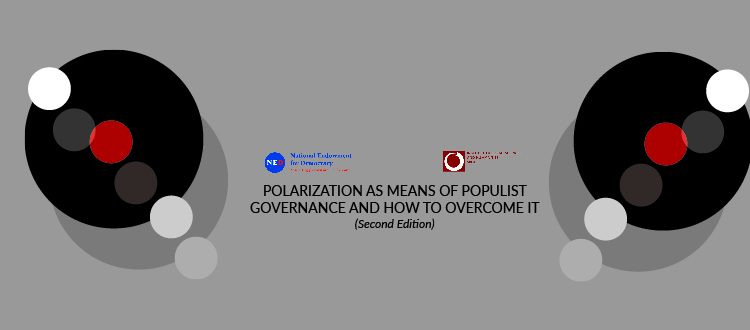POLARIZATION AS MEANS OF POPULIST GOVERNANCE AND HOW TO OVERCOME IT (Second Edition)
Polarization of a society is a matter of polarization of discourse: it is about constructing a narrative of a history of conflict and about constructing an identity of the opponent. Polarization takes place in language, by way of language whereas its consequences are material and can amount to conflict, violence or atrocities.[1] According to some authorities in the fields of communication studies of polarization and conflict, the construction of the enemy works by way of discursive manipulation of emotions. This is a method that excludes rational examination because the latter implies some form of a dialogue – investigation of the arguments of the other side, their validity and their factuality. That is why polarization of discourse seeks to operate by means of emotions: outrage, hate, personification of the narrative and interests of the opposing side in line with the logic of a plane fable, their embodiment are villains (as opposed to the heroes of the other side). Monique José Ratheiser-van der Velde has studied the phenomenon as an established method of politics of polarization and has offered a structural analysis of its instruments and the social roles of its participants. According to Ratheiser-van der Velde, there are three basic laws of polarization:
Polarization is a “thought-construct, at whose core lies the dichotomy of two constructed, opposing identities: a ‘we’ and a ‘they’ […]” (2018: 38)
- “The second law is that polarization needs fuel. The thought construct of what ‘they’ are like against the way ‘we’ are needs to be reaffirmed continuously.” (2018: 39)
- “The third law is that polarization is driven by emotion, not rationality or logic. It is an emotional dynamic.” (2018: 40)
- As noted above, rationality ought to be excluded because it necessarily leads to the examination of the counter narrative.
In the processes of generation of a polarized discourse, one of competing, confronting and mutually excluding narratives, there are 5 roles or types of agency, according to Ratheiser-van der Velde (2018) and Bart Brandsma (2016).[2] The first group is called “the pushers” consisting of those who create, maintain and exacerbate the polarization by way of not only painting an almost fictional image of the adversary but also creating hate toward those who seek to preserve neutrality. In other words, the neutrals are equally a target to the pushers as are the political opponents – until they become “joiners.” The second group then is called the “joiners”: pressed to step out of the neutral zone as pressure zone, a joiner chooses one of the opposing sides. The “joiners” join not only spontaneously, as the result of their sense of affinity to one of the groups but also because neutrality or reluctance becomes unsustainable or unbearable. The status of “traitors” the neutrals are reduced to – accused of tacit complicity with the demonized adversary – is equally targeted – if not more – than that of the adversary. As there is no dialogue, no direct exchange with the adversary – any possibility of communication is precluded, even an adversarial one – the image of the enemy is almost mythic, unreal as any humanization would undermine the fiction of “pure evil.” Thus, as the adversary is rendered unreal, the only form of humanity that can be attacked as such and called out to join is that of the “neutral.” The third category is, therefore, that of the “silent.” They choose not to choose sides, and as neutrality is under attack they remain silent and seek to stay “invisible” (do not appear in the media and do not voice clearly their neutrality or reluctance to choose sides). The “silent” are the majority and they choose neutrality not so much as a political stance but rather as reluctance toward violence (even if it is only in the verbal form). The fourth group are “the bridge builders” – they seek to reconcile the differences by insisting on the similarities rather than differences between the groups, or on humanizing the difference instead of demonizing it. The methods of the “bridge builders” are doomed to fail, argues Ratheiser-van der Velde (2018), as they maintain the logic of identity and build upon the established thought-construct of the identity-image of the enemy as well as of one’s own group.
Although the motivation of the bridge builder is to secure peace and establish harmony, his action only affirms polarization; the starting point of dialogue still being the difference between the poles and the topic of discussion still being identity. However, much is stressed that the identity of the other is OK too, it is still a ‘different one from ours’ and, therefore, by definition suspect. Ratheiser-van der Velde (2018: 42-43)
The fifth group, according to Brandsma and Ratheiser-van der Velde, is the scape-goat: the moment the middle ground, silence or neutrality becomes impossible, the pressure of polarization being the all-governing force, a scape-goat is required to carry out complete polarization. Habitually it is the bridge-builder who is turned into a scape-goat. (Ratheiser-van der Velde, 2018: 43). As a consequence, the bridge-builder cannot play the role of a “game changer” as the latter requires change of discourse, a societal vision that goes beyond the reigning dualistic discourse.
———-
[1] Monique José Ratheiser-van der Velde, “Crossing ideological borders: How to contribute to depolarization within society and on a global level?,” World of Media Journal of Russian Media and Journalism Studies Issue 1, 2018 (Moscow, 2015), 35-48 (DOI: 10.30547/worldofmedia.1.2018.3).
[2] Bart Brandsma, Polarisatie: inzicht in de dynamiek van wij-zij denken (Schoonrewoerd: BB in Media: 2016).
Polarization as Means of Populist Governance and How to Overcome It (Second Edition)

